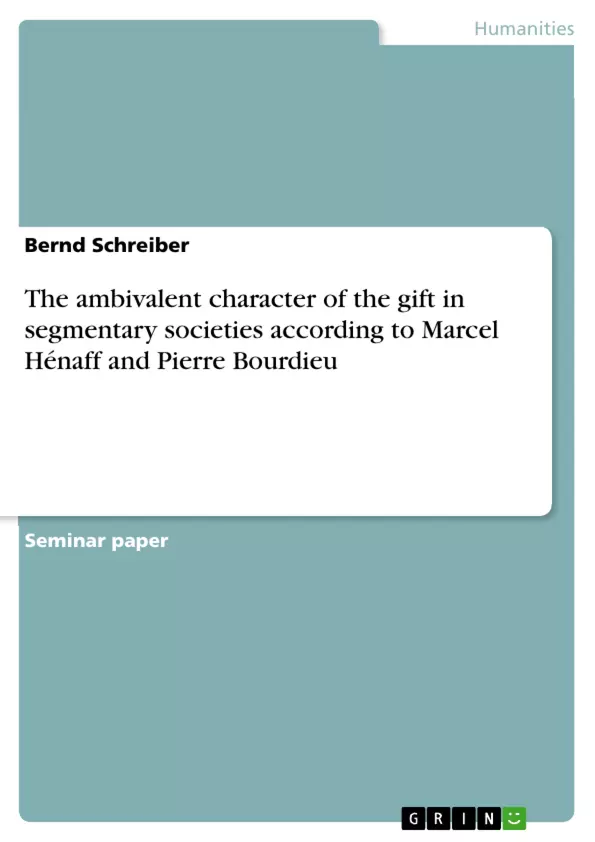Are gifts disinterested presents, challenges geared to rivalry and fighting, offers of social reciprocal recognition, or an exchange of goods on a pure economic base? Sociologists, psychologists, ethnologists and philosophers have discussed these questions for decades, initiated in many cases by the "Essai sur le don" by Marcel Mauss, written in 1924/25 about the form and reason for exchange in archaic societies. Reciprocity, social totality, anti-utilitarianism and amalgamation of souls and things are the main issues of his ethnographic fundamental and systematic comparative study of the exchange of gifts.
Following Moebius, the consequential intense receptions can be substantially divided into two main strands. On the one hand, there is the anti-utilitarianism mindset. While the former idea emphasizes an anti-economic, and unproductive wasteful perception, the latter structure-centered view sees the exchange of goods as a supra-subjective structure, caused unconsciously by the mind with its ability to symbolize and - following Bourdieu - to be thoroughly economic and benefit-oriented. In a different approach Caillé tries to overcome the antagonism of both lines by his so-called "third paradigm". He suggests to avoid the one-dimensional view of holistic vs. individualistic, rationally vs. voluntary, but to speak of the four different cornerstones of human activity, which interact parallel with different intensity.
These cornerstones are voluntariness, obligation, interest and altruism. The occurrence of contrasting characteristics as paradox phenomena of the gift is particularly picked up by Marcel Hénaff in a highly regarded approach, directing attention to reciprocal recognition and the creation of a social bond. This seminar paper will investigate the ambivalent character of the gift. Between and within the two main strands mentioned, there exists such an argumentative width and depth, that it is essential for the feasibility with reasonable effort to restrict the considerations related to the number of protagonists and aspects. The limitation will refer to two approaches, firstly, Marcel Hénaff and his view of the ceremonial gift and secondly, Pierre Bourdieus understanding of the giving procedure. As starting points and sources of the statements, "Der Preis der Wahrheit" and "Die Gabe der Philosophen" as well as "Entwurf einer Theorie der Praxis" are used.
Inhaltsverzeichnis (Table of Contents)
- Introduction
- The ceremonial gift exchange according to Marcel Hénaff
- The three categories of the gift
- Delimitation of the ceremonial gift
- Characteristics of the ceremonial gift
- Objective of the ceremonial gift
- The gift term according to Pierre Bourdieu
- Challenge and response to challenge
- Concept of habitus and symbolic capital
- The time factor
- The praxeological approach
- The ambivalence on the view of the gift
- The ambivalent character of the ceremonial gift according to Hénaff
- The ambivalent character of the (gift) behavior according to Bourdieu
- Summary and appraisal
Zielsetzung und Themenschwerpunkte (Objectives and Key Themes)
This seminar paper investigates the ambivalent character of the gift. Focusing on the approaches of Marcel Hénaff and Pierre Bourdieu, the paper examines the ceremonial gift as a form of reciprocal recognition and social bonding. It delves into the key concepts of gift exchange, including the dialectic of challenge and response, habitus, symbolic capital, and the time factor.
- The ceremonial gift as a form of reciprocal recognition and social bonding
- The ambivalent nature of the gift, encompassing both economic and non-economic aspects
- The role of habitus and symbolic capital in the gift exchange process
- The time factor and its influence on the interpretation of the gift
- The distinction between objective reality and subjective truth in the context of the gift
Zusammenfassung der Kapitel (Chapter Summaries)
- Chapter 1: This chapter presents Marcel Hénaff's approach to the ceremonial gift. It begins by clarifying the concept of the gift and then focuses on the delimitation and characteristics of the ceremonial gift. Finally, it examines Hénaff's interpretation of the ceremonial gift as a form of reciprocal recognition aimed at establishing a social bond.
- Chapter 2: This chapter explores Pierre Bourdieu's perspective on the gift. It delves into the "dialectic of challenge and response of challenge" based on Bourdieu's studies in Kabylia (Algeria). The chapter further examines Bourdieu's praxeological approach, highlighting the role of habitus and the time difference between gift and counter-gift. This leads to Bourdieu's two levels of objective reality and subjective truth.
- Chapter 3: This chapter focuses on the ambivalent view of the gift. It examines the ambivalent character of the ceremonial gift according to Hénaff and the ambivalent character of gift behavior according to Bourdieu.
Schlüsselwörter (Keywords)
The primary keywords and focus topics of the text include: ceremonial gift, reciprocal recognition, social bond, challenge and response, habitus, symbolic capital, time factor, praxeological approach, objective reality, subjective truth, ambivalence, and gift exchange.
- Quote paper
- Dr. Bernd Schreiber (Author), 2015, The ambivalent character of the gift in segmentary societies according to Marcel Hénaff and Pierre Bourdieu, Munich, GRIN Verlag, https://www.grin.com/document/386157



